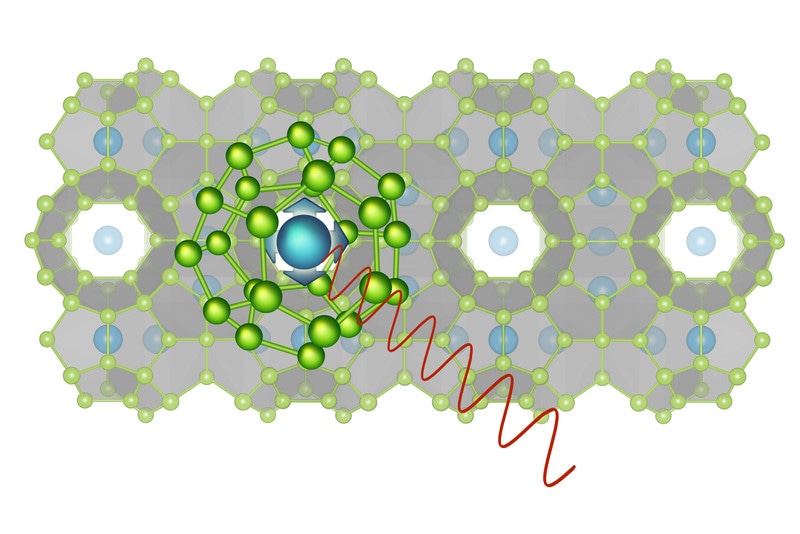Feb 22 2019
A new effect has been uncovered by physicists, which enables the production of exceptional thermal insulators that conduct electricity. With such materials, waste heat can be converted into electrical energy.
 The atom in the cage can oscillate in two different directions. (Image credit: TU Wien)
The atom in the cage can oscillate in two different directions. (Image credit: TU Wien)
On a daily basis, valuable energy is lost in the form of waste heat in technical devices at home; however, it is also lost in large energy systems. A part of it could be retrieved by using the “thermoelectric effect.” It is possible to directly convert the heat flow from a hot device to the cold environment into electrical power. However, materials with very unique properties are needed in order to achieve that. These materials must have good electrical conductivity but bad thermal conductivity—two requirements which are difficult to bring together.
Scientists worldwide are in search of such materials. Some materials with a cage-like structure have proved to specifically show promise, for example, clathrates, which are investigated at TU Wien. Presently, a significant effect has been shown following detailed investigations, which can describe the principally low thermal conductivity of these materials.
Prison Cells for Atoms
Clathrates are crystals with a very special structure. Their crystal lattice contains tiny cages in which individual atoms are locked up. These atoms can oscillate back and forth in their single cell, without seeing much of the rest of the crystal.
Silke Bühler-Paschen, Professor, Institute of Solid State Physics, Vienna University of Technology.
In a solid, heat is produced by means of vibrations of its atoms. On heating a crystal, the vibrations get stronger until a certain point where the bonds between the atoms are broken and the crystal melts. “There are two types of vibrations,” says Silke Bühler-Paschen. “If neighboring atoms are strongly bound together, then the vibration of one atom can be directly transferred to its neighbors and a heat wave spreads through the material. The stronger the coupling between the atoms, the faster the propagation of the wave and the greater the heat conduction. However, if an atom is only very weakly bound to its neighbors, just like the atom sitting in the clathrate cage, then it is largely independent of the others and the heat wave is extremely slow.”
New Effect: The Kondo-Like Phonon Scattering
As part of his thesis with Silke Bühler-Paschen, Matthias Ikeda found out that specific interaction between these two kinds of heat wave allows clathrates to be such good thermal insulators. Matthias Ikeda carried out accurate and wide-ranging measurements. A range of crystals, each one with somewhat different properties, was developed at TU Wien and carefully quantified.
In the end, we were able to prove what nobody wanted to believe us at first: there is a hitherto unknown physical effect that suppresses the thermal conductivity - we call it Kondo-like phonon scattering.
Matthias Ikeda, Vienna University of Technology.
Since it has a crystal structure, an atom in the clathrate cage vibrates desirably in two particular directions. “When a heat wave arrives, it can—for a short time—enter a kind of bound state with such a vibration. The heat wave changes the oscillation direction of the atom in the clathrate cage,” states Silke Bühler-Paschen. “This process slows down the heat wave, and so the heat conductivity is decreased. Even though clathrates conduct electricity, they are good thermal insulators.”
Better Material for Thermoelectrics
This is literally the required combination of material properties in order to employ the thermoelectric effect on an industrial scale. Using the appropriate material, something hot is joined to something cold, and the energy flow between them can be directly converted into electricity. On one hand, the material must conduct electricity, while on the other hand, it should not balance the temperatures by conducting the heat so rapidly, or else the effect cannot be employed anymore.
The project was very time-consuming, in addition to numerous experiments, extensive computer simulations had to be developed in order to understand the quantum physical processes behind this effect. But it was worth it: With our concept of Kondo-like phonon scattering, it is now much easier to understand the behavior of clathrates and therefore we can work more purposefully to find the most efficient materials for thermoelectric applications.
Silke Bühler-Paschen, Professor, Institute of Solid State Physics, Vienna University of Technology.